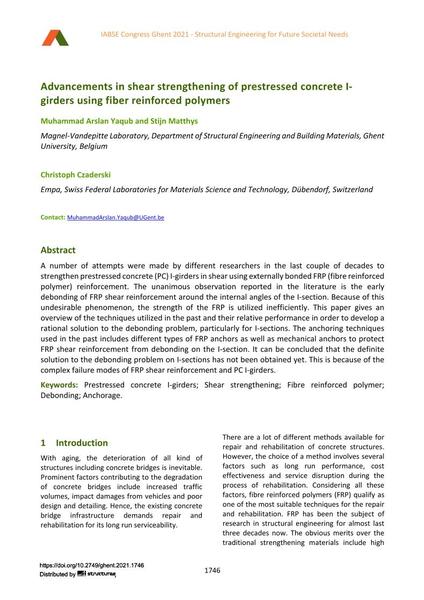Advancements in shear strengthening of prestressed concrete I-girders using fiber reinforced polymers

|
|
|||||||||||
Détails bibliographiques
| Auteur(s): |
Muhammad Arslan Yaqub
(Magnel-Vandepitte Laboratory, Department of Structural Engineering and Building Materials, Ghent University, Belgium)
Stijn Matthys (Magnel-Vandepitte Laboratory, Department of Structural Engineering and Building Materials, Ghent University, Belgium) Christoph Czaderski (Empa, Swiss Federal Laboratories for Materials Science and Technology, Dübendorf, Switzerland) |
||||
|---|---|---|---|---|---|
| Médium: | papier de conférence | ||||
| Langue(s): | anglais | ||||
| Conférence: | IABSE Congress: Structural Engineering for Future Societal Needs, Ghent, Belgium, 22-24 September 2021 | ||||
| Publié dans: | IABSE Congress Ghent 2021 | ||||
|
|||||
| Page(s): | 1746-1753 | ||||
| Nombre total de pages (du PDF): | 8 | ||||
| DOI: | 10.2749/ghent.2021.1746 | ||||
| Abstrait: |
A number of attempts were made by different researchers in the last couple of decades to strengthen prestressed concrete (PC) I-girders in shear using externally bonded FRP (fibre reinforced polymer) reinforcement. The unanimous observation reported in the literature is the early debonding of FRP shear reinforcement around the internal angles of the I-section. Because of this undesirable phenomenon, the strength of the FRP is utilized inefficiently. This paper gives an overview of the techniques utilized in the past and their relative performance in order to develop a rational solution to the debonding problem, particularly for I-sections. The anchoring techniques used in the past includes different types of FRP anchors as well as mechanical anchors to protect FRP shear reinforcement from debonding on the I-section. It can be concluded that the definite solution to the debonding problem on I-sections has not been obtained yet. This is because of the complex failure modes of FRP shear reinforcement and PC I-girders. |
||||
| Mots-clé: |
ancrage
|
||||
| Copyright: | © 2021 International Association for Bridge and Structural Engineering (IABSE) | ||||
| License: | Cette oeuvre ne peut être utilisée sans la permission de l'auteur ou détenteur des droits. |
||||
